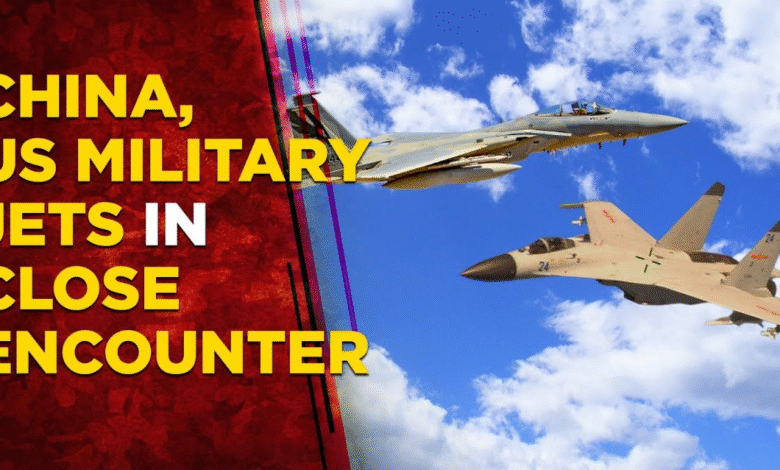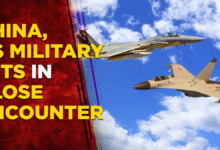China US Fighter Jet Encounter: A Tense Dance in the Skies

The latest China US fighter jet encounter over the South China Sea highlights rising tensions, high-tech confrontations, and global stakes in modern aerial warfare.
The skies above the South China Sea have become a growing arena for military tension, and the recent China-US fighter jet encounter is just the latest chapter in a long and complex story. As two global powers with clashing interests and ideologies, the United States and China frequently find themselves at odds in this strategically significant region. While encounters between their militaries aren’t entirely new, the latest incident involving fighter jets has sparked fresh discussions about international airspace, military provocation, and the precarious balance of power in Asia.
In this article, we take a closer look at the China-US fighter jet encounter, diving into its geopolitical implications, what led to the tense situation, how these kinds of aerial confrontations happen, and what the broader global impact could be. We’re not here to spread sensationalism—just a clear, insightful analysis of a high-stakes event that affects more than just two countries. This is an expert take, written for both curious minds and informed readers looking for a deeper understanding.
Setting the Stage: The South China Sea as a Flashpoint
The South China Sea has long been a hotbed of geopolitical conflict, and not just because of its clear blue waters and rich marine biodiversity. Beneath those waters lies a treasure trove of natural resources—oil, gas, and fisheries—and above them, crucial international shipping lanes carry trillions of dollars in trade annually.
China claims nearly all of the South China Sea under its controversial “nine-dash line,” a demarcation not recognized by most of the international community. Meanwhile, the United States doesn’t claim territory there, but it conducts regular Freedom of Navigation Operations (FONOPs) to challenge Beijing’s sweeping claims. So, it’s no surprise that a China-US fighter jet encounter would eventually happen in these tense skies.
What makes these encounters even more serious is that both sides believe they’re acting within their rights. China claims to be protecting its territorial sovereignty. The US insists it’s defending international law. When fighter jets from both nations cross paths at high speeds, each with their own mission and set of protocols, it creates a highly volatile mix.
Anatomy of an Aerial Encounter: What Really Happened
The latest China-US fighter jet encounter took place over international airspace, yet close enough to Chinese-claimed territory to trigger a swift response. According to official statements, a US reconnaissance aircraft was intercepted by a Chinese fighter jet in what American officials described as an “unsafe maneuver.”
The Chinese pilot reportedly flew dangerously close to the US aircraft, sometimes within just a few feet. The U.S. military later released footage of the incident, showing the Chinese jet approaching at a high speed before veering off. China, however, called the maneuver a “necessary action” in response to what it termed an intrusion.
Incidents like these aren’t just about close calls—they’re about testing limits. China’s military has increasingly challenged US military aircraft operating near its claimed territories. At the same time, the US has stepped up surveillance missions, arguing that the airspace is international and must remain open for all nations.
While no shots were fired, the tension in such encounters is palpable. Pilots on both sides have split seconds to make decisions, and one wrong move could lead to catastrophe. Think of it as a high-stakes chess match played at supersonic speeds.
Diplomatic Repercussions: Words, Warnings, and Strategic Messaging
Whenever a China-US fighter jet encounter makes the headlines, it’s not long before diplomats and defense officials weigh in. The US typically accuses China of aggression, citing the risks such maneuvers pose to international peace and security. China, in turn, accuses the US of provocation and meddling in regional affairs.
These incidents often lead to a flurry of press conferences, formal protests, and back-channel communications. But rarely do they produce lasting solutions. Instead, each encounter becomes another piece of evidence cited in broader strategic debates. It’s like throwing more logs on an already smoldering fire.
This pattern reveals something deeper: the absence of a robust conflict de-escalation mechanism between the two nations. While hotlines exist, trust is lacking. China US Fighter Jet Encounter That’s dangerous, considering how quickly an encounter can escalate from a standoff to a tragedy.
The Role of Technology in Modern Aerial Engagements
Modern fighter jets aren’t just about speed and agility—they’re flying computers equipped with advanced radar, AI-assisted targeting systems, and complex communication protocols. In the recent China-US fighter jet encounter, both sides were flying some of their most advanced aircraft.
China’s J-16 multirole fighter, for example, is built for speed, power, and versatility. On the US side, reconnaissance aircraft like the RC-135 or P-8 Poseidon are equipped with sophisticated surveillance systems designed to collect real-time intelligence. These aren’t casual flybys; these are strategic moves in a high-tech war game.
With technology, however, comes a new layer of complexity. Miscommunication or electronic interference could make an already dangerous situation worse. Despite all the high-tech gear, trust and communication protocols are still key to avoiding disaster. Machines can do a lot, but they can’t replace judgment in the cockpit.
Historical Context: This Isn’t the First Time
This latest encounter isn’t a one-off event—it’s part of a long history of China-US military interactions in and around the South China Sea. One of the most infamous incidents occurred in 2001, when a Chinese fighter jet collided with a US EP-3 reconnaissance plane. The collision killed the Chinese pilot and forced the American aircraft to make an emergency landing in China.
That incident triggered a major diplomatic standoff. Since then, both militaries have increased their activities in the region, leading to more frequent and intense encounters. Each time, the stakes seem to get a little higher, the rhetoric a little sharper, and the need for clear communication even more urgent.
Understanding this history is crucial because it reveals a pattern. These encounters are not random—they are the physical manifestation of two strategic visions clashing in real time. The more we recognize the patterns, the better prepared we are to anticipate future risks.
Global Reactions and Regional Impacts
A China-US fighter jet encounter doesn’t just echo in Washington and Beijing—it reverberates around the world. Allies and partners on both sides watch closely, trying to gauge what it means for their own security.
For countries in Southeast Asia, such as the Philippines, Vietnam, and Malaysia, these encounters are a cause for concern. They fear being caught in the crossfire, either militarily or diplomatically. Meanwhile, allies like Japan and Australia often increase their own surveillance or patrol activities in solidarity with the United States.
On a broader scale, incidents like these shape how global powers interact. NATO members may use them to justify enhanced cooperation in the Indo-Pacific. China, for its part, may respond by forging closer military ties with Russia or ramping up its own regional presence.
The Media and Public Perception

How the media frames a China-US fighter jet encounter can significantly affect public perception. In the US, headlines often focus on Chinese aggression. In China, the narrative centers on American provocation. The truth often lies somewhere in between but is harder to convey in a 15-second news clip.
Social media further complicates things. Footage from the encounter can go viral within minutes, triggering nationalistic sentiment and fueling calls for military action. In an age where attention spans are short, and emotions run high, managing public perception becomes just as important as managing military strategy.
The risk here is that sensationalism can drown out nuance. If people only hear one side of the story, they’re less likely to support diplomacy and more likely to back confrontation. That’s why balanced, informed reporting matters more than ever.
Strategies for De-Escalation: What Can Be Done?
So, what’s the way forward? How can China and the US avoid future fighter jet encounters turning deadly? The answer lies in a mix of diplomacy, transparency, and mutual respect for international norms.
One possible solution is the establishment of clearer aerial engagement protocols, similar to those used between the US and Soviet Union during the Cold War. These would spell out what pilots can and cannot do when operating in proximity to each other. Another option is expanding the use of military hotlines to prevent misunderstandings.
Joint military exercises, while rare between China and the US, could also build trust if done under the right conditions. Even dialogue forums—where military leaders can talk candidly—could help reduce the risk of escalation. None of these steps are easy, but they’re far better than the alternative.
Table: Comparison of US and Chinese Fighter Jet Capabilities
| Feature | Chinese J-16 | US F-22 Raptor |
|---|---|---|
| Speed | Mach 2+ | Mach 2.25 |
| Combat Range | ~1,500 km | ~3,000 km (with tanks) |
| Weapons | Missiles, bombs | Stealth missiles, bombs |
| Avionics | Advanced radar, jamming systems | Stealth, supercruise, advanced radar |
| Role | Multirole fighter | Air superiority |
Quote to Consider
“In a world of great powers and great ambitions, the skies are no longer a frontier—but a flashpoint.”
Frequently Asked Questions (FAQs)
Q: What triggered the recent China-US fighter jet encounter?
A: The encounter was sparked by a US reconnaissance mission near Chinese-claimed territory in the South China Sea. A Chinese fighter jet intercepted the US aircraft, leading to a close and tense interaction.
Q: Are these kinds of encounters common?
A: Yes, they’ve become increasingly common over the past decade as both China and the US ramp up their military activities in contested regions.
Q: Was this encounter in international airspace?
A: According to US officials, the encounter occurred in international airspace. China, however, often claims expanded airspace around territories it considers its own.
Q: Could this lead to war?
A: While it’s unlikely to lead directly to war, such encounters increase the risk of miscalculation, which could spark a broader conflict if not managed properly.
Q: How do these encounters affect global relations?
A: They contribute to rising tensions between China and the US, influence regional security policies, and can shape the strategic decisions of other global players.
Conclusion: Navigating the Skies with Caution
The China-US fighter jet encounter is more than a mid-air standoff—it’s a symbol of larger geopolitical currents pulling in opposite directions. As both nations continue to test boundaries in the air and on the sea, the risk of a dangerous misstep looms large. Preventing conflict will require not just sharper pilots, but sharper diplomacy, better communication, and a renewed commitment to international norms. The skies may be vast, but there’s little room for error when global peace is on the line.




